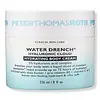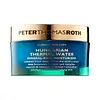What's inside
What's inside
 Key Ingredients
Key Ingredients

 Benefits
Benefits

 Concerns
Concerns

 Ingredients Side-by-side
Ingredients Side-by-side

Water
Skin ConditioningCetearyl Alcohol
EmollientGlycerin
HumectantGlyceryl Stearate
EmollientStearic Acid
CleansingCaprylic/Capric Triglyceride
MaskingIsopropyl Myristate
EmollientSodium Hyaluronate
HumectantAscorbic Acid
AntioxidantTocopheryl Acetate
AntioxidantPanthenol
Skin ConditioningButyrospermum Parkii Butter
Skin ConditioningSaccharide Isomerate
HumectantSodium Phytate
Sodium Hydroxide
BufferingPotassium Sorbate
PreservativeSodium Benzoate
MaskingCitric Acid
BufferingSodium Citrate
BufferingPolysorbate 60
EmulsifyingDimethicone
EmollientCarbomer
Emulsion StabilisingPEG-100 Stearate
Cetyl Ethylhexanoate
EmollientEthylhexylglycerin
Skin ConditioningPhenoxyethanol
PreservativeWater, Cetearyl Alcohol, Glycerin, Glyceryl Stearate, Stearic Acid, Caprylic/Capric Triglyceride, Isopropyl Myristate, Sodium Hyaluronate, Ascorbic Acid, Tocopheryl Acetate, Panthenol, Butyrospermum Parkii Butter, Saccharide Isomerate, Sodium Phytate, Sodium Hydroxide, Potassium Sorbate, Sodium Benzoate, Citric Acid, Sodium Citrate, Polysorbate 60, Dimethicone, Carbomer, PEG-100 Stearate, Cetyl Ethylhexanoate, Ethylhexylglycerin, Phenoxyethanol
Water
Skin ConditioningDimethicone
EmollientPEG/PPG-18/18 Dimethicone
EmulsifyingCetyl Alcohol
EmollientGlyceryl Stearate
EmollientPEG-100 Stearate
Cholesterol
EmollientC12-15 Alkyl Benzoate
AntimicrobialLauryl PEG-9 Polydimethylsiloxyethyl Dimethicone
Skin ConditioningCeramide NP
Skin ConditioningRetinyl Palmitate
Skin ConditioningTocopheryl Acetate
AntioxidantAscorbyl Palmitate
AntioxidantGlycerin
HumectantAdenosine
Skin ConditioningHoney
HumectantDiamond Powder
AbrasivePhospholipids
Skin ConditioningTrehalose
HumectantHelianthus Annuus Seed Oil
EmollientLinum Usitatissimum Seed Oil
PerfumingOenothera Biennis Oil
EmollientPrunus Armeniaca Kernel Oil
MaskingPrunus Persica Kernel Oil
EmollientHippophae Rhamnoides Oil
EmollientRosmarinus Officinalis Leaf Extract
AntimicrobialPaeonia Lactiflora Root Extract
Skin ConditioningFagus Sylvatica Bud Extract
TonicSaccharomyces/Magnesium Ferment
Leuconostoc/Radish Root Ferment Filtrate
AntimicrobialSaccharomyces/Iron Ferment
Skin ConditioningSaccharomyces/Copper Ferment
Skin ConditioningSaccharomyces/Silicon Ferment
Skin ConditioningSaccharomyces/Zinc Ferment
Skin ConditioningLecithin
EmollientSodium PCA
HumectantSodium Hydroxide
BufferingPolysilicone-11
Polymethylsilsesquioxane
Mica
Cosmetic ColorantDecyl Glucoside
CleansingEthoxydiglycol
HumectantCarbomer
Emulsion StabilisingDisodium EDTA
Butylene Glycol
HumectantPropylene Glycol
HumectantHexylene Glycol
EmulsifyingCaprylyl Glycol
EmollientBenzoic Acid
MaskingBenzyl Alcohol
PerfumingSodium Benzoate
MaskingPotassium Sorbate
PreservativePhenoxyethanol
PreservativeWater, Dimethicone, PEG/PPG-18/18 Dimethicone, Cetyl Alcohol, Glyceryl Stearate, PEG-100 Stearate, Cholesterol, C12-15 Alkyl Benzoate, Lauryl PEG-9 Polydimethylsiloxyethyl Dimethicone, Ceramide NP, Retinyl Palmitate, Tocopheryl Acetate, Ascorbyl Palmitate, Glycerin, Adenosine, Honey, Diamond Powder, Phospholipids, Trehalose, Helianthus Annuus Seed Oil, Linum Usitatissimum Seed Oil, Oenothera Biennis Oil, Prunus Armeniaca Kernel Oil, Prunus Persica Kernel Oil, Hippophae Rhamnoides Oil, Rosmarinus Officinalis Leaf Extract, Paeonia Lactiflora Root Extract, Fagus Sylvatica Bud Extract, Saccharomyces/Magnesium Ferment, Leuconostoc/Radish Root Ferment Filtrate, Saccharomyces/Iron Ferment, Saccharomyces/Copper Ferment, Saccharomyces/Silicon Ferment, Saccharomyces/Zinc Ferment, Lecithin, Sodium PCA, Sodium Hydroxide, Polysilicone-11, Polymethylsilsesquioxane, Mica, Decyl Glucoside, Ethoxydiglycol, Carbomer, Disodium EDTA, Butylene Glycol, Propylene Glycol, Hexylene Glycol, Caprylyl Glycol, Benzoic Acid, Benzyl Alcohol, Sodium Benzoate, Potassium Sorbate, Phenoxyethanol
Ingredients Explained
These ingredients are found in both products.
Ingredients higher up in an ingredient list are typically present in a larger amount.
Carbomer is a polymer of acrylic acid. Its main role is to create a gel consistency.
A high amount of carbomer can cause pilling or balling up of products. Don't worry, most products contain 1% or less of carbomer.
Dimethicone is a type of synthetic silicone created from natural materials such as quartz.
What it does:
Dimethicone comes in different viscosities:
Depending on the viscosity, dimethicone has different properties.
Ingredients lists don't always show which type is used, so we recommend reaching out to the brand if you have questions about the viscosity.
This ingredient is unlikely to cause irritation because it does not get absorbed into skin. However, people with silicone allergies should be careful about using this ingredient.
Note: Dimethicone may contribute to pilling. This is because it is not oil or water soluble, so pilling may occur when layered with products. When mixed with heavy oils in a formula, the outcome is also quite greasy.
Learn more about DimethiconeGlycerin is already naturally found in your skin. It helps moisturize and protect your skin.
A study from 2016 found glycerin to be more effective as a humectant than AHAs and hyaluronic acid.
As a humectant, it helps the skin stay hydrated by pulling moisture to your skin. The low molecular weight of glycerin allows it to pull moisture into the deeper layers of your skin.
Hydrated skin improves your skin barrier; Your skin barrier helps protect against irritants and bacteria.
Glycerin has also been found to have antimicrobial and antiviral properties. Due to these properties, glycerin is often used in wound and burn treatments.
In cosmetics, glycerin is usually derived from plants such as soybean or palm. However, it can also be sourced from animals, such as tallow or animal fat.
This ingredient is organic, colorless, odorless, and non-toxic.
Glycerin is the name for this ingredient in American English. British English uses Glycerol/Glycerine.
Learn more about GlycerinGlyceryl Stearate is a mix of glycerin and stearic acid.
It is used to stabilize the mixing of water and oil ingredients. By preventing these ingredients from separating, it can help elongate shelf life. It can also help thicken the product's texture.
As an emollient, it helps soften skin and supports barrier-replenishing ingredients.
In cosmetics, Glyceryl Stearate is often made from vegetable oils or synthetically produced.
This ingredient may not be fungal-acne safe
Fun fact: The human body also creates Glyceryl Stearate naturally.
Learn more about Glyceryl StearatePeg-100 Stearate is an emollient and emulsifier. As an emollient, it helps keep skin soft by trapping moisture in. On the other hand, emulsifiers help prevent oil and water from separating in a product.
PEGS are a hydrophilic polyether compound . There are 100 ethylene oxide monomers in Peg-100 Stearate. Peg-100 Stearate is polyethylene glycol ester of stearic acid.
Phenoxyethanol is a preservative that has germicide, antimicrobial, and aromatic properties. Studies show that phenoxyethanol can prevent microbial growth. By itself, it has a scent that is similar to that of a rose.
It's often used in formulations along with Caprylyl Glycol to preserve the shelf life of products.
Potassium Sorbate is a preservative used to prevent yeast and mold in products. It is commonly found in both cosmetic and food products.
This ingredient comes from potassium salt derived from sorbic acid. Sorbic acid is a natural antibiotic and effective against fungus.
Both potassium sorbate and sorbic acid can be found in baked goods, cheeses, dried meats, dried fruit, ice cream, pickles, wine, yogurt, and more.
You'll often find this ingredient used with other preservatives.
Learn more about Potassium SorbateSodium Benzoate is a preservative. It's used in both cosmetic and food products to inhibit the growth of mold and bacteria. It is typically produced synthetically.
Both the US FDA and EU Health Committee have approved the use of sodium benzoate. In the US, levels of 0.1% (of the total product) are allowed.
Sodium benzoate works as a preservative by inhibiting the growth of bacteria inside of cells. It prevents the cell from fermenting a type of sugar using an enzyme called phosphofructokinase.
It is the salt of benzoic acid. Foods containing sodium benzoate include soda, salad dressings, condiments, fruit juices, wines, and snack foods.
Studies for using ascorbic acid and sodium benzoate in cosmetics are lacking, especially in skincare routines with multiple steps.
We always recommend speaking with a professional, such as a dermatologist, if you have any concerns.
Learn more about Sodium BenzoateSodium Hydroxide is also known as lye or caustic soda. It is used to adjust the pH of products; many ingredients require a specific pH to be effective.
In small amounts, sodium hydroxide is considered safe to use. However, large amounts may cause chemical burns due to its high alkaline.
Your skin has a natural pH and acid mantle. This acid mantle helps prevent harmful bacteria from breaking through. The acid mantle also helps keep your skin hydrated.
"Alkaline" refers to a high pH level. A low pH level would be considered acidic.
Learn more about Sodium HydroxideTocopheryl Acetate is AKA Vitamin E. It is an antioxidant and protects your skin from free radicals. Free radicals damage the skin by breaking down collagen.
One study found using Tocopheryl Acetate with Vitamin C decreased the number of sunburned cells.
Tocopheryl Acetate is commonly found in both skincare and dietary supplements.
Learn more about Tocopheryl AcetateWater. It's the most common cosmetic ingredient of all. You'll usually see it at the top of ingredient lists, meaning that it makes up the largest part of the product.
So why is it so popular? Water most often acts as a solvent - this means that it helps dissolve other ingredients into the formulation.
You'll also recognize water as that liquid we all need to stay alive. If you see this, drink a glass of water. Stay hydrated!
Learn more about Water